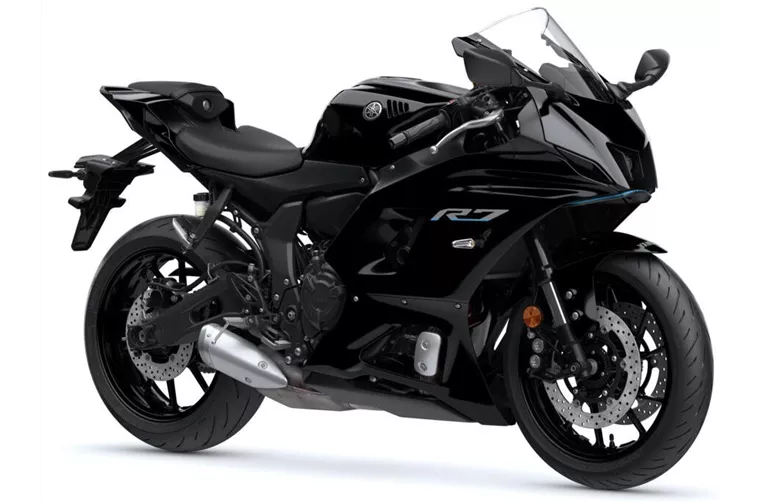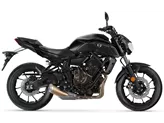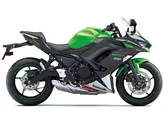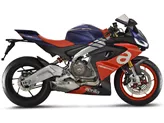Yamaha YZF-R6 2019 vs. Yamaha R7 2022

Yamaha YZF-R6 2019

Yamaha R7 2022
Overview - Yamaha YZF-R6 2019 vs Yamaha R7 2022
The Yamaha YZF-R6 model year 2019 and the Yamaha R7 model year 2022 are both supersport motorcycles manufactured by Yamaha. While they share some similarities in terms of engine type, suspension, and brakes, there are also notable differences between the two models.
In terms of engine and drive train, the Yamaha YZF-R6 2019 is equipped with an in-line, 4-cylinder engine with a displacement of 599cc. It has a bore of 67mm, a stroke of 42.5mm, and a compression ratio of 13.1. The engine produces a power output of 118 HP and a torque of 65.7 Nm. On the other hand, the Yamaha R7 2022 features an in-line, 2-cylinder engine with a displacement of 689cc. It has a larger bore of 80mm and a stroke of 68.6mm, resulting in a lower compression ratio of 11.5. The engine produces a power output of 73.4 HP and a torque of 67 Nm.
Both models feature a DOHC valve system with 4 valves per cylinder. The Yamaha YZF-R6 2019 has a more rev-happy engine, providing a thrilling riding experience with its powerful performance. However, some riders may find that the engine lacks punch in the middle of the rev range. The Yamaha R7 2022, on the other hand, offers a punchy engine with strong performance in the lower and middle rev ranges, making it more suitable for everyday riding.

Yamaha YZF-R6 2019
In terms of suspension, both models are equipped with upside-down telescopic forks at the front and a swing arm with a monoshock at the rear. The Yamaha YZF-R6 2019 has a front fork diameter of 43mm, while the Yamaha R7 2022 has a slightly smaller diameter of 41mm. Both models offer adjustable compression, preload, and rebound settings, allowing riders to fine-tune the suspension to their preferences.
In terms of chassis, the Yamaha YZF-R6 2019 features an aluminum frame, which contributes to its tight and sporty handling characteristics. The Yamaha R7 2022, on the other hand, features a steel frame, which provides a balance between rigidity and flexibility. Both frames are designed to offer stability and precise handling.
Both models are equipped with double disk brakes at the front, utilizing radial technology for improved braking performance. This allows for better heat dissipation and more consistent braking power. The Yamaha YZF-R6 2019 is also equipped with an advanced rider assistance system, including ABS, riding modes, ride by wire, and traction control. The Yamaha R7 2022, however, only features ABS as an advanced rider assistance system.
In terms of dimensions and weights, the Yamaha R7 2022 has a slightly longer wheelbase of 1395mm compared to the Yamaha YZF-R6 2019's 1375mm. The Yamaha R7 2022 also has a slightly lower kerb weight of 188kg compared to the Yamaha YZF-R6 2019's 190kg. Additionally, the Yamaha R7 2022 has a smaller fuel tank capacity of 13 liters compared to the Yamaha YZF-R6 2019's 17 liters.

Yamaha R7 2022
In terms of strengths, the Yamaha YZF-R6 2019 is praised for its top chassis, sporty handling, powerful brakes derived from the YZF-R1, sharp design, modern lighting system, mature electronics package, and a rev-happy engine. On the other hand, the Yamaha R7 2022 is praised for its CP2 engine with punchy performance, front-wheel-oriented seating position, adjustable chassis, manageability, and good brakes.
In terms of weaknesses, the Yamaha YZF-R6 2019 is criticized for its engine lacking punch in the middle rev range and a higher price compared to its competitors. The Yamaha R7 2022, on the other hand, is noted for its lack of a TFT display.
Overall, while both the Yamaha YZF-R6 2019 and the Yamaha R7 2022 are high-performance motorcycles, they cater to different riding preferences. The Yamaha YZF-R6 2019 offers a more aggressive and track-focused riding experience, while the Yamaha R7 2022 provides a more versatile and user-friendly performance suitable for everyday riding.
Technical Specifications Yamaha YZF-R6 2019 compared to Yamaha R7 2022
Pros and Cons in comparison
Pros and Cons in comparison
Yamaha YZF-R6 2019

It almost seems as if the Yamaha YZF-R6 was born on the race track. It is easy to see that the R6 is the little sister of the YZF-R1. Whether it's the design, the ergonomics, the braking or the electronic aids - the racing genes are everywhere! The R6 is an outstanding piece of engineering in the 600cc class and, depending on your preferences, is probably the best 600cc bike currently available - at least for the racetrack. The Yamaha gives the rider unbelievably high precision and feedback over the front wheel and the chassis, and is super manageable at the same time! The engine is extremely rev-happy, but also wants to be kept happy. It is a pity that the latest version of the R6 has lost some of its power due to Euro 4... Nevertheless, it will be the faster track bike for most of us. And if there is a need, an open exhaust system (without road homologation) and mapping can tickle a few more horsepower out of the super sports bike. Sharp design meets even sharper components - TOP!
Yamaha R7 2022

Those who expect the Yamaha R7 to be a half-hearted solution will be surprised at how well-balanced the little supersports bike is. Of course, the engine with just over 70 hp doesn't have what it takes to challenge the R6, for example, but the engine with its punch from below fits the character perfectly. The chassis components are of high quality, even fully adjustable at the front, and the handling of the slim grenade is absolutely awesome. The seating position is fine, not as radical as on a real super sports bike, and therefore suitable for everyday use.
Price Comparison Avarage Market Price Yamaha YZF-R6 vs Yamaha R7
There are a few key differences between a Yamaha YZF-R6 2019 and a Yamaha R7 2022. It takes less time to sell a Yamaha R7 with 87 days compared to 140 days for the Yamaha YZF-R6. Since model year 2005 1000PS.de editors have written 33 reviews for the Yamaha YZF-R6 and 9 reviews for the Yamaha R7 since model year 2021. The first review for the Yamaha YZF-R6 was published on 17/10/2002 and now has more than 3,600 views. This compares to more than 92,800 views for the first review on Yamaha R7 published on 18/05/2021.

















